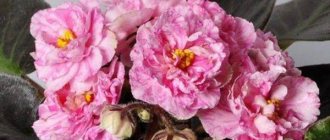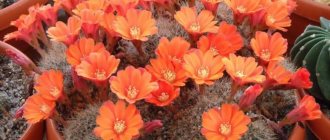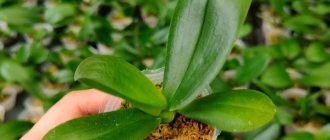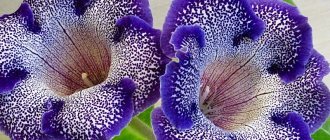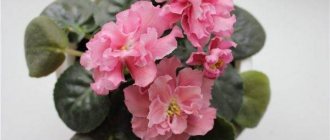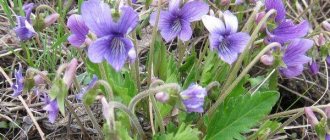Delicate, bright violets took pride of place on the windowsills and shelves of apartments. differ from their relatives growing in natural conditions :
- Long flowering;
- Bright and varied colors;
- And resistance to various environmental factors.
But the most unpretentious variety, with poor care, will not grow with a neat symmetrical rosette and will not produce beautiful cap blooms. Therefore, it is so important to know and follow the recommendations for caring for the Uzambara violet variety.
Violet SM-Almond (Seedling Morev)
History of the variety
Saintpaulia SM-Almond is a seedling of the famous domestic breeder Konstantin Morev .
Despite the fact that Konstantin did not make this hybrid of Uzambara violet a variety, SM-Almond for its bright and large flowers became very popular among:
- Violet collectors;
- And lovers of indoor flowers.
Photo and description of the variety
Violet Moreva Almond is an Uzambara violet that belongs to the Gesneriev family . The Almond seedling delights not only beginners, but also experienced violet growers. Simply huge flowers up to 8-9 cm, amaze not only with their size, but also with their changing color depending on the conditions of detention.
Flowers are found in two color options . In the first case they are a rich coral color, and in the second they are soft peach. Double stars also have a white center, and the edges of the petals are gracefully curved and lighter than the middle.
Violet Almond has two different flower colors.
Attention! Thanks to the dense structure of the petals, the flowers retain their shape throughout the entire flowering period.
Socket:
- Compact and symmetrical;
- Easy to form;
- It has a standard size of 30 to 40 cm in diameter.
Leaves:
- Shiny;
- Round shape;
- Dark green color;
- The edges of the foliage have faint serrations.
Saintpaulia has dark green leaves.
Variegation, imprints
The rosette and leaves are of a standard dark green color, without variegation .
Features of feeding
Violet "almond" is quite sensitive to the content of organic and mineral components in the soil. Fertilizer is carried out during transplantation of green crops, as well as 1.5 - 2 months after it. For this, two types of liquid compositions are used:
- organic fertilizers - special attention should be paid to the timely introduction of nitrogen, phosphorus and potassium into the soil (you can use manure or complex fertilizers intended for violets);
- mineral fertilizers are special chemical mixtures that are produced in the form of liquids and powders (Uniflor, Master, Bona Forte, Fertika and others).
Also, “almonds” react positively to regular watering with a weak solution of potassium permanganate. Such fertilizing slightly increases the acidity of the soil and washes out excess salts from it. In addition, potassium permanganate increases resistance to various diseases in winter.
Caring for a plant at home
The variety is not particularly capricious and, with the right choice of location, proper watering and use of fertilizers, does not require additional attention.
Important! Critical temperatures for violets are below 13 and above 28 degrees.
Conditions of detention
If the rosette is on the windowsill and is not regularly turned with opposite sides to the light source, then the rosette begins to twist the leaves in different directions . With age, the rosette noticeably stretches the stem, so it will have to be replanted often.
This variety can be grown both on a windowsill and on a shelf.
Proper watering and fertilizing
The variety does not like waterlogging . It requires moderate watering and even short-term maintenance in soil that is too waterlogged leads to partial death of the delicate root system of the violet. And regular overwatering can easily destroy even an adult plant.
Experienced gardeners recommend growing this variety using wick irrigation.
Fertilizing is carried out regularly , twice a month during the period of active growth and flowering.
Lighting and temperature
The violet is sensitive to indoor lighting; the best option for growing SM-Almonds is a backlit rack . If you grow a flower on a windowsill, then the east window will be the best choice.
The Almond seedling is also dependent on the room temperature . At the peak of the heat, the petals become monotonous, without whiteness in the center of the flower and along the edges of the petals.
Important! The petals have their varietal color at a temperature of 20-24 degrees.
Air humidity
The humidity in the room should be between 50-70% , if higher or lower, the violet will feel discomfort and bloom poorly.
What kind of soil does he prefer?
The substrate for planting violets is needed :
- Air;
- And loose.
For the plant, they buy a ready-made slightly acidic substrate and add baking powder to it:
- Perlite;
- Or vermiculite.
For rosettes standing on wick watering, use a 1:1 ratio, and for top watering, use a mixture of one part baking powder and three parts soil for violets or high-moor peat.
Pruning and hygiene
Once a month, the violet is given “bath procedures” . The plant is washed off with dust under a weak stream of water. The water temperature should be the same as when watering, and its temperature should not be lower than room temperature.
After “bathing,” the violet is placed in its usual place after the foliage has completely dried. Otherwise, the remaining drops will lead to rotting of the rosette or senile burns, and subsequently the beautiful leaves will be spoiled by yellow spots .
Reproduction methods
The presented variety is propagated by leaf cuttings.
Although the variety is a little slow to reproduce, the babies grow very slowly , but it is worth noting that the variety reproduces well:
- By pinching;
- And leaf cuttings.
If desired, it can also be propagated by planting flower stalks .
Rules for transplantation and rejuvenation
Transplant the rosette into new soil:
- Every six months;
- Or after every third flowering.
Rejuvenate violet:
- Cutting the plant at the root;
- And the flower stalks are removed along with the lower leaves.
The bottom of the stem is peeled like a carrot and placed in a greenhouse until young roots appear.
Violet Fuchsia lace
The Fuchsia lace violet shown in the photo, bred by E. Lebetskaya, will become a spectacular decoration for any window sill or shelf. Thanks to the large double corollas of white flowers, striking combinations of pink and crimson reflections on the petals, the plant will not get lost among the most spectacular plants. The petals are densely corrugated along the edge, and the frill is highlighted with green strokes. The rosette of violet Fuchsia miracle is standard, with wavy dark foliage.
Reviews
Yana. “Having seen the description of the Almond violet variety, I couldn’t believe for a long time that my baby would have the same huge flowers. And now, the long-awaited flowering, the flowers are simply gigantic, with a diameter like a violet pot. I am delighted!"
Larisa. “I bought a starter at an exhibition, and a month later the first flowers bloomed. They are so large, almost 7 cm. And already the second flowering caused a sensation, not only for me, but also for all my friends. Now they unanimously ask for such a baby.”
Saintpaulia is grown by many gardeners.
Stanislava. “Favorite variety! I have never seen such huge flowers anywhere before. The rosette sometimes hugs the pot, but this does not spoil the impression of the variety. It’s on wick watering, no problems with it.”
Violets Arctic Frost
The Arctic Frost violet variety developed by Sorano has a cap of the most delicate white flowers with a wide, blurred border of a dark blue hue. The corollas are simple or semi-double, extremely showy, large and wavy. The foliage is quilted, dark, oval-ovate in shape.
The Arctic frost violet variety sometimes surprises the grower with the appearance of chimeras that produce spectacular flowers with contrasting white stripes in the middle of each petal.
Features of flowering, growth and reproduction
Knowing how to properly root stepchildren and leaf cuttings, growing a daughter rosette will not be difficult . And with proper care, the violet rosette will:
- Produce new and new buds;
- And the huge flowers will delight you with their beauty for a month.
How long does it take to grow an adult plant?
From the moment the cuttings are planted until the tiny babies appear, 2 to 4 weeks pass . It will take a few more months to transplant into separate cups so that the children:
- Got stronger;
- And they gained sufficient leaf mass.
From the moment young violets separate from the mother leaf, another 5 to 7 months will pass .
Attention! Experienced flower growers recommend propagating Almond seedlings by stepsons.
How are varietal characteristics transmitted?
The violet often does not take stepson ; to obtain stepsons, the growth point at the rosette is pinched and nitrogen fertilizer is applied to stimulate growth.
Advice! Seedling by Konstantin Morev - Almonds are best propagated by separating stepchildren.
Another popular method is to root a leaf cutting from the mother rosette.
Features of flowering in hot and cool conditions
The variety is temperature dependent ; in warm conditions there is no white content on the petals at all.
In the warm season, Saintpaulia blooms without white spots.
What do flower stalks look like?
The peduncles of this violet variety are not thick , but strong. Under the weight of the buds they bend slightly, but the flowers hold.
Is it possible to achieve cap flowering?
Most often, about 3-4 buds are formed at the same time , so it cannot be called cap flowering. But, due to the huge size of the flowers, they look like a whole bouquet.
Bud lifespan
increase in size as they open . They remain in dissolution for about one month.
The unusually beautiful seedling of Konstantin Morev Almond, subject to the rules of cultivation and proper care, will delight its owner with huge salmon flowers at any time of the year.
Violet Partly cloudy
The name of the G. Boone selection variety translates as “partly cloudy.” Violet Partly cloudy really has a beautiful smoky color of semi-double flowers of light blue color. The edges of the richer tone are heavily ruffled and decorated with a bright green frill. The petals have visible veins and a speckled pattern. The foliage is green, wavy, with a glossy sheen.
Almond trimming
Fulfilling this point is extremely important for full development. In the spring, this work must be carried out before the sap flows.
Those branches and shoots that by this time have been injured, frozen, dried out or become sick will have to be removed. Sometimes two branches grow too close and interfere with each other. Then they choose a stronger one, and cut off the other one.
After flowering, it is also necessary to prune the tree. This procedure does not harm it at all; on the contrary, if this is done on time, then in a year the flowering will be even more magnificent.
After 7 years of age, the old branches are removed. They are usually replaced by those root suckers that appear when the plant is 3 years old.
Application
Almonds are used not only as a nutritious product. It is used in traditional and folk medicine; cosmetics and aromatic products are made from it.
In cooking
Nuts are consumed both fresh, salted or roasted. Nuts are added to confectionery and cognac products. This use is due to the fact that the product helps give the dish a unique, subtle taste and sweetness.
The nutritional value of the product allows it to be used as a sports food. With the help of almonds, athletes and people losing weight balance the amount of fats and proteins in the body.
Almonds are known as a spice in dishes in folk recipes. In addition, nuts are used to prepare individual desserts - marzipan, praline and others.
In cosmetology
Almond oil is used in cosmetology, which is used as a flavoring agent or an anti-inflammatory agent. Almonds in creams and ointments promote accelerated healing of wounds and damaged skin. Nuts are found in skin care products, shampoos and nail products. The strengthening property of the plant allows it to be used as a healing and strengthening agent.
In medicine
Almonds are included in the list of medicinal plants. Laxatives and preparations for the treatment of pathologies of the stomach and intestines are made from almond oil.
Various ointments, creams, and emulsions are prepared based on almond oil. In some countries, the oil is used as a solvent for injectable drugs.
Almond shells are used in the production of activated carbon.
In folk medicine
Almonds have been used in folk medicine since ancient times. In this case, all types of nuts are used - both bitter and sweet. The oil of the fruit and the bark of the rhizome are used as medicinal raw materials. For treatment, almonds are not only eaten, but also medicinal decoctions and infusions are prepared based on them.
Recipes
- Almond oil for the treatment of headaches - to eliminate headaches, rub a drop of almond oil into your temples.
- Warm almond oil helps in the treatment of otitis media. The product is instilled into the ear, 3-4 drops at a time, then the ear is plugged with cotton wool to retain heat inside.
- To treat stomach ulcers, mix 3 parts of sweet and part of bitter almonds, dilute them with 5 parts of warm milk and take 2 times before meals.
- Hand cream. Almond oil helps with dry skin. The cream is made from equal parts of flax and almond oil, and a few drops of lemon.
In landscape design
The beauty of the flowering plant leads to the fact that today almonds are often used as decorative. In areas, the plant is grown both in groups and as individuals. Trees planted along the paths look decorative. Almonds are also used to make a living fence along the fence. The plant is often planted on lawn grass and in rockeries.
Having thought through the interior of the garden, you can plant almonds in such a way that they become natural shading for the gazebo. The crop is planted on slopes or among garden stones. A large number of bushes can form an alley.
Interesting Facts
- Many scientists are sure that almonds, like peanuts, are not nuts.
- Only sweet varieties are accepted for food.
- In some countries, a nut is placed in the Christmas cake for good luck.
- Despite the fact that almonds are a nut, they are classified as plum nuts.
- America is the main supplier of this crop.
Almond propagation
Varietal almonds can be propagated only by layering, grafting and shoots, while species almonds can also be propagated by seeds. Some gardeners grow rootstocks themselves, and then graft varietal cuttings onto them.
Growing almonds from seed
Seeds are sown in open ground, and this can be done in spring or autumn. It should be noted that before sowing in the spring, the seeds should be prepared; for this, they are placed in the refrigerator on the vegetable shelf for four months. Make furrows in the soil, the depth of which should be from 8 to 10 centimeters, while keeping a distance of 10 to 12 centimeters between the seeds. The gap between the grooves should be 50 centimeters. Almond seedlings that have emerged need care, which consists of timely watering, weeding and loosening the soil surface. In the summer, when the seedling reaches half a meter in height and the thickness of its stem is 10 mm, all its branches, which grow at a height of up to 10 centimeters from the root collar, need to be cut into a ring. Then the plants are transplanted to a permanent place. As soon as they get over the disease, you can begin to plant varietal cuttings on them.
Almond grafting
Rootstocks of any species of this plant are suitable for grafting, but it is recommended to take those that are highly frost-resistant. Almonds grow well on cherry plum, bird cherry, sloe or plum rootstocks. A scion suitable for grafting must be straight, have developed stems with eyes that must be fully formed. All foliage should be removed from the cuttings using pruning shears, leaving only short petioles of a centimeter in length.
This shrub can be propagated by grafting only at a time when sap flow is observed, namely in spring or August. The rootstock, which should grow in open ground, should be carefully wiped with a damp cloth, thereby removing dust and dirt from it. Then, a little above the root collar, you need to make a T-shaped incision using a budding knife. And then carefully turn the cut bark to the sides. The shield, which is a strip of bark with a bud and a thin layer of wood, should be cut off from the scion. Please note that the shield should fit entirely into the T-shaped cut you made earlier, so you do not need to make it too long. When the shield is inserted, you should press the edges of the bark that were previously turned away. To fix the shield, you can use budding tape, tape or adhesive tape, and it is enough to make only a few turns around the barrel. At the same time, remember that the bud with the remainder of the petiole should not be closed.
If the grafting was carried out in the spring, then after half a month the petiole from the bud, which should still be green, should fall off on its own, and the budding tape should be slightly loosened. If the grafting was carried out in August, then the tape should not be removed until the next autumn period, and in late autumn the grafted seedling must be covered with soil (the grafting site must be covered with soil). With the onset of spring, it is necessary to remove the soil so that the root collar is free, and the fixing tape is also removed.
Cuttings
Planting material for cuttings should be prepared from mid to late June. To do this, semi-lignified apical cuttings are cut, which should have 2 nodes, their length varies from 15 to 20 centimeters. Then the cuttings must be immersed in a growth stimulating agent for 16 hours. Their rooting should be done in a cold greenhouse. For planting, use a soil mixture consisting of peat and sand (2:1). The cuttings will take root completely after 20–30 days. According to statistics, 85–100 percent of cuttings take root. When roots appear, the cuttings will need to be transplanted into a training bed for growing.
How to propagate by shoots
To provoke active growth of shoots around the bush, severe pruning should be done. The separated offspring must have a fully formed root system, and this will happen only in the second year. The offspring transplanted to a permanent place must be cared for in the same way as a one-year-old seedling.
How to propagate by layering
It is necessary to bend the flexible stems to the soil surface, secure them with metal pins, and then sprinkle them with earth. During the time until the root system is formed in the cuttings, they should be provided with timely watering, weeding and loosening of the soil surface. It will be possible to separate the cuttings and plant them in a permanent place only after 12 months. During this time, its root system should be fully formed.
Decorative almonds in landscape design
The successful combination of properties and picturesqueness of the shrub allow the plant to look good at any time of the year. It is planted in the background of lawns, rock slides, against the background of conifers and boulders.
A group of 3-5 almonds on a trunk in landscape design grows very quickly, creating luxurious spherical bushes with rich flowering that will look great along the fence, against the backdrop of large bushes or low trees and edges.
Almond compositionSource i.ytimg.com
Considering that the nut grows tall, it needs to be planted where there is plenty of space. If you plant almond bushes in your landscape design too close to other plants, then over time the foliage will shade the entire space around.
Watch the video on how to care for three-lobed almonds:
Violet Magenta
Breeder E. Lebetskaya, who created the Magenta violet shown in the photo, managed to combine in one plant both unusual flowers of a thick red-wine hue and a beautiful rosette of pointed-ovate leaves. The corollas are double or semi-double, large. Along the edge of the wavy petals there is a thin, intermittent white border. The Magenta violet rosette is standard, even in shape.
Culture transplantation
Usually, the almond violet is replanted as needed, but such a procedure should be carried out at least twice a year in the initial stages of life. Such actions help to significantly increase the decorative qualities of the plant and resistance to various diseases.
To grow violets, it is recommended to use a container that is 3–4 centimeters larger than the diameter of the plant’s root system. The depth of the pot should be 6 - 9 centimeters (depending on the volume of the roots). In addition, the size of the flowerpot must correspond to the volume of the outlet.
You should not immediately plant a flower in a large pot, counting on its rapid growth. In this case, the violet will actively grow its root system and leaves, but the buds will not grow. In addition, in a pot that is too spacious, various fungal diseases can develop.
Violet Amadeus
Looking at the photo of the Amadeus violet, one cannot help but admire the freshness of the crimson hue on the wavy petals, the size of the corollas and the brightness of the elegant white border.
The flowers blooming on the rosettes of this variety are densely double, with a whitened center. The more the corolla opens, the brighter the colors. The leaves of the Amadeus violet are simple, round-oval in shape, and medium green in color. part 1
part 2
part 3
part 4
part 5

